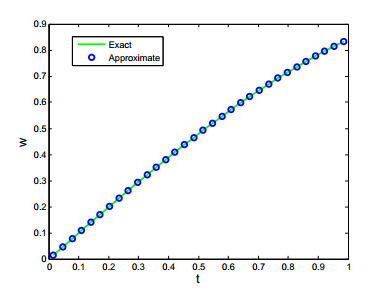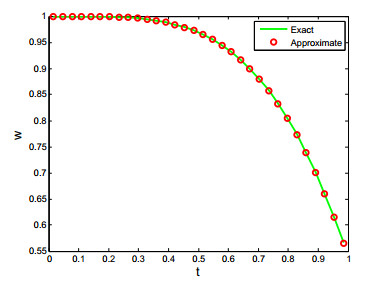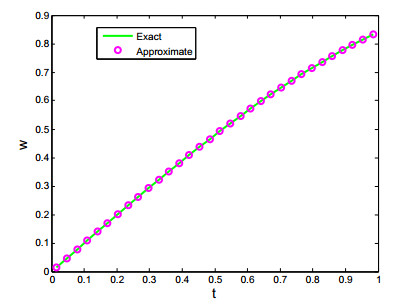1.
Introduction
Fractional calculus is an extension of the integer order calculus by considering derivatives of arbitrary order. Fractional calculus is as old as the conventional analytic proposed by Newton and Leibniz in 1695. These equations are used for modelling of various phenomena in the field of science, engineering, physical chemistry, electric circuits and mechanical systems. In the literature, various variable order (VO) fractional operators can be found. Some of them are definitions of Riemann Liouville, Grunwald, Marchaud Coimbra, and Caputo. Many physical phenomena show characteristics of fractional-order that varies with time, or space, or with space and time. Several numerical methods have been published in literature for the solution of VO fractional integro-differential equations (FIDEs). Some methods are: Finite difference technique [1], Legendre wavelet [2], Chebyshev polynomials [3], Bernstein polynomials [4], spectral method [5,6]. A cubic Spline interpolation method for solution of VO FIDE with weakly singular kernels was used by Moghaddam and Machado [7]. Tavares et al. [8] used Caputo derivatives for solution of VO FIDE.
Samko and Ross [9] used the Riemann-Liouville definition and Fourier transforms to investigate integration and differentiation of functions of a VO. Samko [10] provides an overview of a number of studies on fractional operations of integration and differentiation of variable order where the order varies from point to point. Patnaik et al. [11] gives a concise and extensive overview of the progress made in the development of VO fractional calculus analytical and computational approaches for simulation of physical systems. Variable and distributed order fractional operators were studied by Lorenzo and Hartley [12]. To synchronies VO fractional chaotic systems, Escamilla et al. [13] proposes a state observer based technique. Aziz et al. [14] developed a predator prey model with a constant VO and a time fractional VO. Patnaik and Jokar [15] studied that how the VO continuum mechanics theory was developed and how it was applied to the study of nonlocal heterogeneous solids. With power-law, exponential-law, and Mittag-Leffler kernels. Pérez et al. [16] studied a novel extended numerical scheme for modelling VO fractional differential operators.
The Haar wavelets are the mathematically simplest of all wavelet families since they are made up of piecewise constant functions. These wavelets have the characteristic to be integrated analytically arbitrary times. The advantage of Haar technique is its simplicity and less computation costs, the proposed technique take less CPU time and provides better solution in terms of accuracy.
The Chen and Hsiao approach is commonly used in the literature for numerical solution of many differential equations [17]. Haar wavelet collocation technique (HWCT) was used for the numerical solution of differential equations [18], integral equations [19]. Pioneering work of Lepik in the development of HWCT can be seen in [20,21,22,23]. The convergence of HWCT is proved by Majak et al. [24,25]. Higher order HWCT as an improvement of HWCT was recently introduced by Majak et al. in [26,27,28,29]. The free vibrations analysis of the Euler-Bernoulli nanobeam was studied in [30].
HWCT is more suitable for solution of initial as well as boundary value problems. This technique gives good accuracy for less collocation points. The HWCT is very feasible for detecting singularities of irregular structures. The HWCT is developed for solution of the following linear Volterra Fredholm FIDEs
with initial condition w(0)=λ, Dα(t) is VO Caputo derivative, M1(t,s), M2(t,s) are smooth functions known as kernel of integration which are closed and bounded functions over the square [0,1]×[0,1] and a, b, c, and f:[0, 1]→R are continuous functions.
The following is how the paper is structured: Section 2 contains the preliminaries. In Section 3 HWCT scheme for solution of VO linear FIDEs is discussed. Some examples are given in Section 4. In the last part 6, the conclusion is given.
2.
Preliminaries
Definition 2.1. Scaling function on [α1,α2) is [31]
Mother wavelet on [α1,α2) is
The rest of the terms can be written as
where η1=α1+(α2−α1)ζd,η2=α1+(α2−α1)ζ+0.5d,η3=α1+(α2−α1)ζ+1d, where d=2r, and ζ=0,1,…,d−1. If we take interval [0,1], then values of η1, η2 and η3 are : η1=ζd, η2=1/2+ζd, η3=1+ζd. Any function belonging to square integrable function space L2[0,1), is u(t)=∑∞k=1λkhk(t), just for approximation, we truncate this series at N terms, u(t)≈∑Nk=1λkhk(t).
Using the notation
and
Generally,
Thus [31],
Some of the work using HWC scheme can be found in [32,33,34,35].
Definition 2.2. The interval [β1,β2] for HWCT is discretized as [36]
In the above Eq (2.8), collocation points (CPs) are defined.
Remark 2.3. The integral in Eq (1.1) is calculated by the following formula [37]
3.
Numerical method
Here, we developed the numerical scheme HWCT for solution of Eq (1.1). We follow Haar technique adopted by Lepik in [23]. By applying Caputo definition, Eq (1.1) becomes
If we take α(t) between 0 and 1, then n=1, so Eq (3.1) becomes
Let w′(t)∈L2[0,1), then w′(t) is written as
where the unknown coefficients of the Haar wavelet are ai and by the process of Gauss elemination, we need to find these coefficients. Integrating Eq (3.3), we obtain the following expression
After integration and using initial condition, we have
where
By applying Haar approximations to Eq (1.1), we get
We get the following expression after simplification
substituting the CPs in above equation, we have
It is possible to write above expression in matrix form as
where
We use the Lepik [23] method to calculate value of matrix M.
For this, we have cases.
Case ⅰ. If tj<0, so hi(tj)=0. Thus M(j,i)=0.
Case ⅱ. If tj∈[α,β), then
Case ⅲ.If tj∈[β,γ). Then
Case ⅳ. If tj∈[γ,1), so
Thus the matrix M is given by
Hence ai's can be obtained as A=M−1B. Finally, by putting ai=1,2,3,…,N in the above Eq (3.4), the approximate solution at CPs is determined.
4.
Numerical examples
To show the convergence of the HWCT scheme, some examples are given in this section. If wex denotes the exact and wap denotes approximate solution at CPs, so Ecp maximum absolute error is Ecp=max|wexc−wapc|, and the Mcp mean square root error in CPs is defined as Mcp=√1N(∑Ni=1|wexc−wapc|2). Rcp is used for convergence rate and is given by:
Problem 4.1. Consider the following VO FIDEs [6]
where α1(t)=16sin(10πt)+23, α2(t)=et−t2 and f is so that exact solution is w(t)=sint.
Problem 4.2. Consider the following VO FIDEs [6]
where α1(t)=t2−t+0.8, α2(t)=esin(5πt)t and f is so that exact solution is w(t)=cos(t2).
Problem 4.3. Consider following VO FIDEs [6]
where α1(t)=1−0.01t and f is so that exact solution is w(t)=sint and ∫t0w(t)(t−s)sin2tds=Γ(α2)Iα2(t)w(t) with α2(t)=1−sin2(t).
5.
Results and discussion
The first Caputo definition is applied with a combination of Haar functions. The errors are calculated for various number of CPs. Tables 1–3 show errors Ecp, Rcp, and Mcp for Examples 4.1–4.3 respectively. From the tables, we see that both errors are reduced by increasing the number of CPs. The rate of convergence which is equivalent to 2, is also calculated supporting the analytical results proved by Majak et al. [24]. The solution comparisons between the exact and the approximation for 32 different number of CPs is shown in Figure 1, represent the comparison of numerical and exact solution of Example 4.1 for 32 CPs, Figure 2, represent comparison of Example 4.2 for 32 CPs, and Figure 3, represent comparison of Example 4.3 for 32 CPs. One can see from the figures that the exact and approximate solutions close to each other.
6.
Conclusions
In this work, the collocation method is developed based on Haar wavelet for the solution of linear VO FIDEs. The HWCT is very convenient for solving VO FIDEs with initial conditions because during the process of determining the expression of the approximate solution, the initial conditions are taken into account automatically. The Haar functions are used for approximation of ordinary derivatives and Caputo derivative is used for VO fractional derivative. A system of linear equations is obtained by replacing CPs using the HWCT. Gauss elimination is used for the solution of this system. Finally, the solution at CPs is found by using these coefficients. To show the applicability and consistency of the HWCT method, some examples are given. For all computational work, MATLAB software is used.
Conflict of interest
The authors declare that they have no competing interests.









 DownLoad:
DownLoad:






